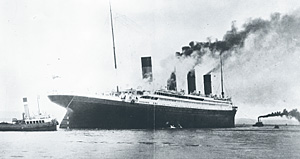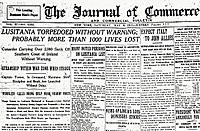|
|
The 1900's-2000's:
11
12
13
14
15
16
17
18
19
20
21
22
< previous
next >
How the JoC covered
the Titanic disaster
In its edition of Monday, April 15, 1912, The Journal of Commerce was already preparing for the expected triumphant arrival in New York later that week of the Titanic, the newest trans-Atlantic liner vessel and the most lavish one ever built. Above the fold on the front page the JoC carried an article about the surge in construction of ever more expensive and opulent liners that would be entering service in the next few years. "The arrival this week of the new White Star liner Titanic, the sister ship of last year's Olympic, closely followed by the French Line's France, once again calls attention to the procession of new vessels of the largest size by which the trans-Atlantic passenger fleet is continuously being reinforced," the JoC stated in its lead paragraph. "The shipyards of Great Britain, Germany and France are all fully employed in turning out vessels of greater size and luxury than their predecessors."
| Wireless transmissions provided first word of 1912 tragedy |
But in a late edition in the column adjacent to that story, the paper inserted an ominous, late-breaking report. Based on initial wireless transmissions received in Montreal via Cape Race, the 250-word story said the Titanic had "been in collision with an iceberg and asked for aid," and that other ships were racing to its assistance.
The Titanic, sailing at full speed through a cloudless night, had brushed the iceberg at about 9:50 p.m. New York time (in those pre-time-zone days, it was 11:40 p.m. where the Titanic was located). The ship issued its first distress call at 10:25 p.m. New York time, at which point word spread rapidly. At some point that evening, the JoC and other newspapers received their first word of the unfolding disaster. Little was actually known. When the JoC received its first story, it was possible the ship was still afloat, since the Titanic didn't sink until 12:10 p.m.
 |
| The Titanic |
In their initial, sketchy reports, newspapers revealed how inconceivable such a catastrophe would have appeared, and by extension why the sinking was seen as an epoch-ending event. Early editions of London newspapers went to press under the belief that everyone aboard the ship survived, and some editorials even congratulated those involved for having defied the perils of the sea.
The JoC joined in. Its first story contained this hopeful observation, "As the vessel's equipment included practically all the devices that modern ingenuity could conceive of, it is thought that the vessel is in no great danger."
When the full tragic picture emerged, the newspaper carried the story in full detail, running survivor lists, a story about the shortage of lifeboats, and devoting particular attention to the insurance ramifications. It reported the sinking to be the largest-ever loss sustained by Lloyd's.
The paper's coverage illustrated the widespread misinformation surrounding the event, noting that reinsurance risks on the ship surged to "60 guineas per cent" on the first news of the iceberg strike, but then settled down to 25 guineas per cent later "when it was announced that she was not sinking and in tow of another ship."
No ship, of course, ever towed the Titanic anywhere. |
Willis, whose father was a newspaper publisher and mother a Universalist minister, had earned his doctorate from the University of Chicago. At the time he became the JoC's Washington correspondent, he was a professor at Washington and Lee University and would soon join the faculty of George Washington University as professor of finance.
But Willis had his eyes fixed on the Far East. In 1904 he persuaded Dodsworth to send him to Japan, China and the Philippines. While covering business in the Far East for the JoC and the Engineering and Mining Journal, Willis also found the time to help revise the banking system of the Philippines.
His work led to the establishment of the Philippine National Bank, as the territory's central bank in 1916, and Willis became its first president.
Willis returned to the U.S. and to the JoC in New York in time to witness the Panic of 1907, which underscored the need for a system to ensure liquidity in the financial system. Willis and Dodsworth were of like minds about the need for banking reform and sound monetary policies.
Willis teamed up with Carter Glass, the patrician Virginian who became known as the father of the Federal Reserve System, to write the act that created the Fed. Much of the work was done in the offices of The Journal of Commerce.
Upon Dodsworth's death in 1910, he was succeeded by his son, John W., who appointed Willis associate editor. Willis also began to lecture on economics at Columbia University, where he became a professor of banking in 1917.
Besides its authoritative economics coverage and continued championing of free trade, the JoC differentiated itself from other daily newspapers in New York with its perspective on breaking news. The paper's editors always knew where their readers' interests lay. Its coverage of the San Francisco earthquake of 1906 included a front-page report on how the disaster would affect business ("Anxiety in New York Business Circles/ Merchants Awaiting Definite News of the Disaster/The Stock Market Reflects the Shock of the Calamity - Fears of the Influence on the Money Situation - Dry Goods, Grocery and Packing Interests in Destroyed District.")
 |
| JoC coverage of the Lusitania sinking included an article on the effect on stock prices. |
The day before the Titanic sank, the paper reported on the tremendous growth of the trans-Atlantic passenger fleet. And then, on April 16, when the Titanic disaster dominated the headlines of the general press, the JoC used the sinking as a secondary story on the front page. The rest of the page was devoted to an analysis of the disaster's impact on the insurance and maritime industries.
The articles on the front pages from the years leading up to World War I continued this perspective. When the Lusitania was torpedoed and sunk by a German submarine in 1915, the paper reported the cargo losses, as well as passenger losses. A page one article analyzed the impact on the financial markets.
The 1900's-2000's:
11
12
13
14
15
16
17
18
19
20
21
22
< previous
next > |


